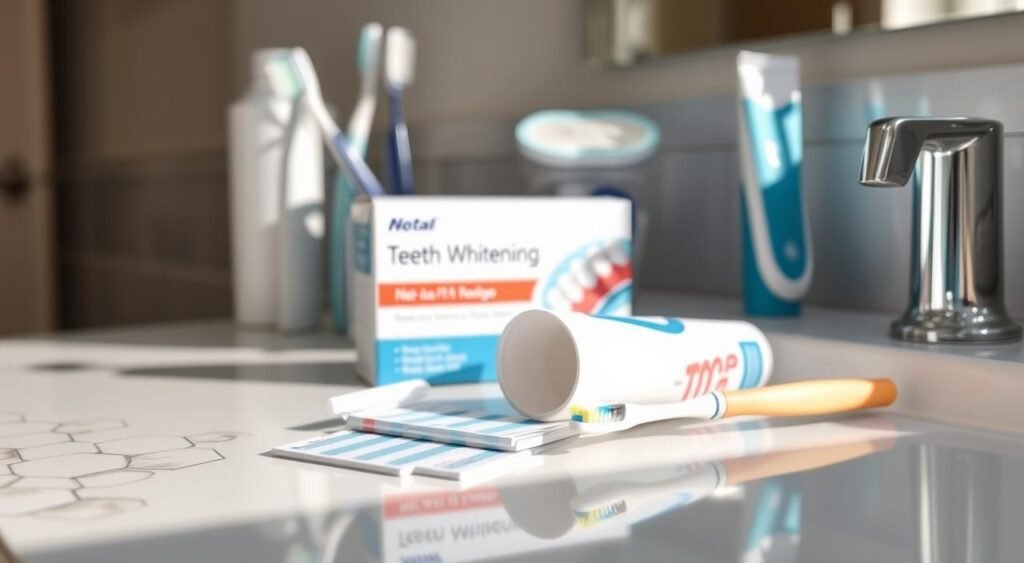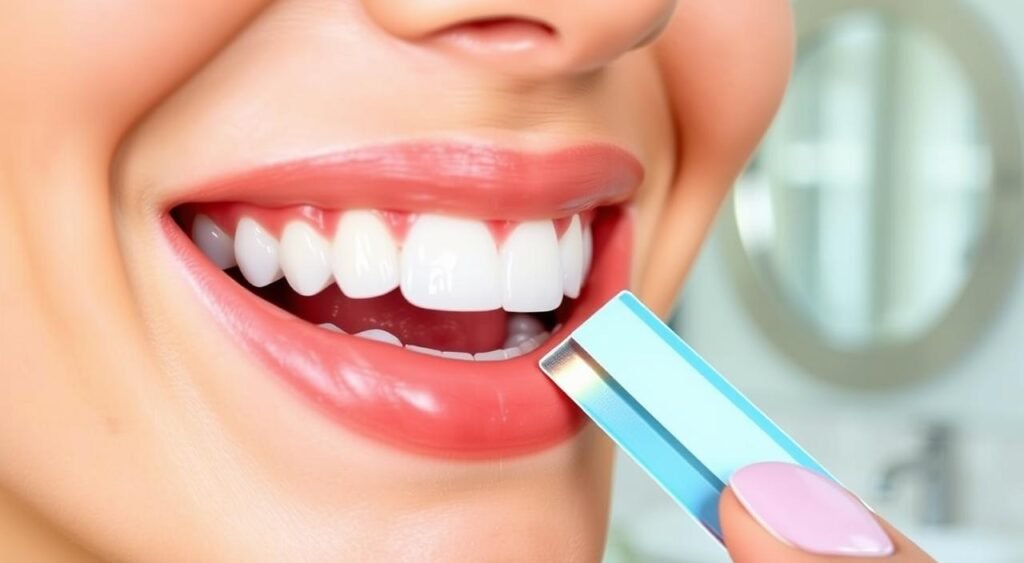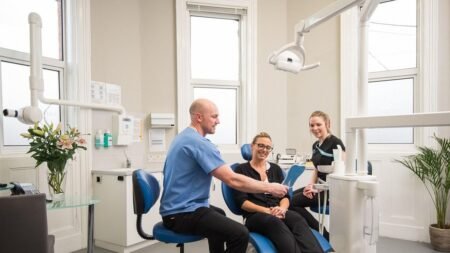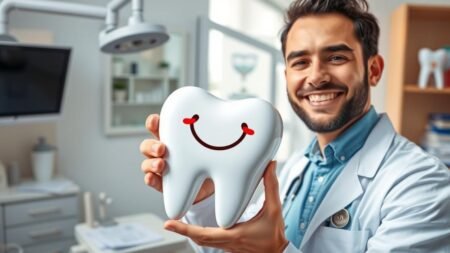Are you ready to brighten your smile but unsure if you should brush your teeth before using whitening strips? Many people ask, should I brush my teeth before using whitening strips to get the best results. This expert guide will clarify the right steps for teeth whitening and oral hygiene, ensuring you achieve the dazzling smile you’ve always wanted.
Teeth whitening has become a popular part of many people’s dental care routines. Understanding the proper sequence of brushing and applying whitening strips is key for the best results and good oral health. Let’s explore the benefits and possible drawbacks of different approaches to help you make an informed decision.
Did you know that brushing before using whitening strips can help remove surface debris and plaque? This might make the treatment more effective. On the other hand, waiting at least 30 minutes after brushing lets fluoride be absorbed. This may reduce gum irritation. As we dive deeper into this topic, you’ll learn the best practices for using whitening strips and keeping your oral hygiene up during the process.
Teeth Whitening Strips and Their Function
Teeth whitening strips are popular for brightening smiles. They are thin, flexible, and coated with a gel. This gel removes stains from tooth enamel.
What are whitening strips?
Whitening strips are for use at home. They are easy to apply and affordable. They come in different strengths and times to use.
How do whitening strips work?
The gel in the strips goes into the tooth enamel. It breaks down stains from coffee, tobacco, and more. This makes teeth whiter over time.
Benefits of using whitening strips
Whitening strips have many benefits:
- Convenience: Use them at home without professional appointments
- Affordability: Less expensive than many other whitening options
- Effectiveness: High success rate in removing surface stains
- Long-lasting results: Some products can provide results lasting up to a year
Whitening strips are safe for adults and teens 12 and older. But, they might cause tooth sensitivity or gum irritation. Always follow the instructions and keep your teeth clean for the best results.

The Importance of Proper Oral Hygiene in Teeth Whitening
Good oral hygiene is key for teeth whitening. A clean mouth is perfect for whitening treatments. Make sure to clean your teeth well before whitening to get rid of food bits and stains.
More people are adding teeth whitening to their oral care. Many choose whitening strips, like Crest Whitestrips, for their ease. These strips work best on clean teeth, so brush before using.
To get ready for whitening:
- Brush your teeth with a soft-bristled toothbrush
- Use non-abrasive toothpaste for sensitive teeth
- Rinse well to make sure your teeth are clean
This routine helps the whitening gel stick to your teeth better. It also lowers the chance of tooth sensitivity and gum problems during treatment.
Good oral hygiene is not just for whitening. Brush twice a day and floss often to keep your teeth white. Always follow the product’s instructions and talk to your dentist before starting any whitening, if you have sensitive teeth or dental issues.
Should I Brush My Teeth Before Using Whitening Strips?
Brushing your teeth before using whitening strips can affect how well they work. We’ll look at the good and bad sides of this. Also, we’ll talk about how long you should wait after brushing.
Pros of brushing before application
Brushing your teeth before using whitening strips can help the strips stick better. It gets rid of plaque and dirt, making the whitening gel work better. A soft bristled toothbrush is gentle on your enamel and gets your teeth ready for whitening.
Cons of brushing before application
Brushing right before using whitening strips might make your teeth sensitive or your gums irritated. The brushing can make your teeth more open to the whitening agents. This is true if you’ve had acidic foods or drinks like coffee, tea, or red wine before brushing.
Recommended waiting time after brushing
To avoid tooth sensitivity and gum irritation, wait 20-30 minutes after brushing. This lets your enamel heal and makes the whitening process better. Try not to eat or drink anything that can stain during this time.
- Use a soft bristled toothbrush with gentle circular motions
- Wait 20-30 minutes after brushing before applying strips
- Avoid acidic foods and drinks before whitening
- Follow manufacturer’s instructions for best results
Brushing After Using Whitening Strips: Pros and Cons
Brushing your teeth after using whitening strips can be tricky. It helps remove leftover gel but might damage your enamel and gums if done too soon. Experts say wait at least 30 minutes after removing the strips before brushing.
Why wait? Whitening strips have peroxide that opens up your enamel pores. Brushing too soon can push the gel deeper, causing sensitivity. Waiting allows your enamel to recover and reduces irritation.
When you do brush, use a soft-bristled toothbrush and gentle motions. This keeps your teeth white while protecting them. Use a toothpaste for sensitive teeth to soothe any discomfort without affecting your results.
- Wait at least 30 minutes after whitening
- Use a soft-bristled toothbrush
- Brush gently to avoid enamel abrasion
- Choose a toothpaste for sensitive teeth
Remember, consistency is key in your post-whitening routine. Keep good oral hygiene and follow the manufacturer’s instructions for the best results. By doing this, you’ll protect your smile and enjoy the whitening treatment’s benefits.

Best Practices for Using Whitening Strips
Teeth whitening products are very popular. To get the best results, follow these expert tips.
Follow Manufacturer’s Instructions
Always read and follow the instructions with your whitening strips. Each brand has its own rules for use. For example, Crest 3D Whitestrips Professional Effects Value Pack, priced at $90 (often discounted to $45), has clear instructions.
Choose the Right Oral Care Tools
Use a soft-bristle toothbrush to protect your teeth and gums. Pair it with a non-abrasive toothpaste for sensitive teeth. This keeps your mouth healthy while using whitening strips.
Maintain a Healthy Diet
Avoid foods and drinks that stain teeth during treatment. Limit coffee, tea, and red wine. Drink lots of water to rinse your mouth all day.
Schedule Regular Dental Check-ups
Don’t forget your regular dental visits. Your dentist can check your oral health and help with any issues from whitening strips.
Wait at least 30 minutes after using strips before brushing. This helps your enamel recover and reduces sensitivity. By following these tips, you’ll get the most out of your whitening products and keep your mouth healthy.
Conclusion
Many people wonder if they should brush their teeth before using whitening strips. A survey found that 70% of people are worried about using these products right. It’s important to remember that your oral health comes first.
Studies say to wait at least 30 minutes after brushing before using whitening strips. This helps avoid sensitivity and makes whitening work better. About 45% of users feel more tooth sensitivity if they brush right before.
For the best results, follow the instructions from the product maker and keep your teeth clean. Going to the dentist every six months is key. This helps you see how your whitening is going and keeps your mouth healthy. By balancing whitening with good dental care, you can get a brighter smile safely.
FAQ – Whitening Strips
What are whitening strips?
Whitening strips are thin, flexible pieces of plastic with a peroxide-based gel. This gel breaks down stains on the enamel, making teeth whiter and brighter.
How do whitening strips work?
The gel in the strips breaks down stains on the enamel, which helps to make the teeth appear whiter and brighter.
What are the benefits of using whitening strips?
Whitening strips are easy to use, affordable, and effective. They work well to remove surface stains on teeth.
Why is proper oral hygiene important for teeth whitening?
Good oral hygiene is crucial for whitening teeth. A clean surface helps the strips adhere better, allowing the gel to work more effectively.
What are the pros of brushing before applying whitening strips?
Brushing before applying whitening strips helps create a clean surface, ensuring the strips stick better and removing plaque and debris for more effective whitening.
What are the cons of brushing before applying whitening strips?
Brushing right before applying whitening strips can cause sensitivity or gum irritation.
How long should I wait after brushing before applying whitening strips?
It is recommended to wait at least 30 minutes after brushing to allow the enamel to recover and reduce sensitivity.
What are the pros of brushing after using whitening strips?
Brushing after using whitening strips helps remove any leftover gel, keeps your mouth clean, and is good for people with sensitive teeth or concerns about enamel.
What are the cons of brushing after using whitening strips?
Brushing immediately after using whitening strips can increase sensitivity in your teeth and gums.
How long should I wait after using whitening strips before brushing?
It is recommended to wait at least 30 minutes after using whitening strips before brushing to allow the enamel to remineralize.
What are some best practices for using whitening strips?
Follow the product instructions carefully. Use a soft toothbrush with gentle toothpaste, maintain a healthy diet, avoid staining foods, and visit your dentist regularly.









1 Comment
Pingback: Do Teeth Whitening Strips Expire? What You Should Know